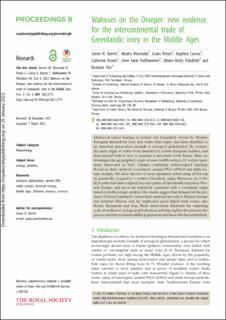| dc.contributor.author | Barrett, James | |
| dc.contributor.author | Khamaiko, Natalia | |
| dc.contributor.author | Ferrari, Giada | |
| dc.contributor.author | Cuevas, Angelica | |
| dc.contributor.author | Kneale, Catherine | |
| dc.contributor.author | Hufthammer, Anne Karin | |
| dc.contributor.author | Pálsdóttir, Albína Hulda | |
| dc.contributor.author | Star, Bastiaan | |
| dc.date.accessioned | 2023-01-25T13:41:20Z | |
| dc.date.available | 2023-01-25T13:41:20Z | |
| dc.date.created | 2022-04-22T19:36:08Z | |
| dc.date.issued | 2022 | |
| dc.identifier.issn | 0962-8452 | |
| dc.identifier.uri | https://hdl.handle.net/11250/3046356 | |
| dc.description.abstract | Mediaeval walrus hunting in Iceland and Greenland—driven by Western European demand for ivory and walrus hide ropes—has been identified as an important pre-modern example of ecological globalization. By contrast, the main origin of walrus ivory destined for eastern European markets, and then onward trade to Asia, is assumed to have been Arctic Russia. Here, we investigate the geographical origin of nine twelfth-century CE walrus specimens discovered in Kyiv, Ukraine—combining archaeological typology (based on chaîne opératoire assessment), ancient DNA (aDNA) and stable isotope analysis. We show that five of seven specimens tested using aDNA can be genetically assigned to a western Greenland origin. Moreover, six of the Kyiv rostra had been sculpted in a way typical of Greenlandic imports to Western Europe, and seven are tentatively consistent with a Greenland origin based on stable isotope analysis. Our results suggest that demand for the products of Norse Greenland's walrus hunt stretched not only to Western Europe but included Ukraine and, by implication given linked trade routes, also Russia, Byzantium and Asia. These observations illuminate the surprising scale of mediaeval ecological globalization and help explain the pressure this process exerted on distant wildlife populations and those who harvested them. | en_US |
| dc.language.iso | eng | en_US |
| dc.publisher | The Royal Society | en_US |
| dc.rights | Navngivelse 4.0 Internasjonal | * |
| dc.rights.uri | http://creativecommons.org/licenses/by/4.0/deed.no | * |
| dc.title | Walruses on the Dnieper: new evidence for the intercontinental trade of Greenlandic ivory in the Middle Ages | en_US |
| dc.type | Journal article | en_US |
| dc.type | Peer reviewed | en_US |
| dc.description.version | publishedVersion | en_US |
| dc.rights.holder | Copyright 2022 the authors | en_US |
| dc.source.articlenumber | 20212773 | en_US |
| cristin.ispublished | true | |
| cristin.fulltext | original | |
| cristin.qualitycode | 2 | |
| dc.identifier.doi | 10.1098/rspb.2021.2773 | |
| dc.identifier.cristin | 2018524 | |
| dc.source.journal | Proceedings of the Royal Society of London. Biological Sciences | en_US |
| dc.identifier.citation | Proceedings of the Royal Society of London. Biological Sciences. 2022, 289 (1972), 20212773. | en_US |
| dc.source.volume | 289 | en_US |
| dc.source.issue | 1972 | en_US |

